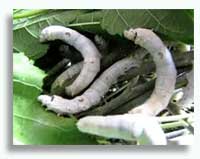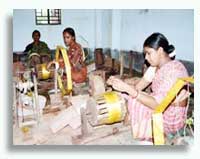SERICULTURE
Introduction
Sericulture is the art and technology of raising silk worms which are meant for production of raw silk yarn. This agro- based industry today is not just limited to just rearing of worms, but even includes all activities related to such field, like mulberry cultivation and even also for post-cocoon technology. It requires both the technical know-how and even specialization. Sericulture is a unique technique of silk production. It is an agro – industry, playing an eminent role in most of the Rural economies. Silk fibre is a protein which is produced from the silk – glands of the silk worms. In India, over and above three million people are employed in various fields of sericulture.
It is a cottage industry and provides various kind of opportunities ample work for the women in the rural areas while men work in the fields. Innovative researches by various research institutes have also shown that mulberry cultivation and silkworm rearing have turned sericulture into an industry. It has become a major cash crop for the country.Today China and Japan are the two main producers of the silk yarn; together they are producing over 50% of the total world production each year.India is the second largest producer of raw silk after China and the biggest consumer of raw silk and silk fabrics. The trends in international silk production suggests that sericulture has better prospects for growth in the developing countries rather than in the developed countries.
Silk production in temperate countries like Japan, South Korea, USSR, etc., is declining steadily not only because of the high cost of labor and heavy industrialization in these countries, but also due to climatic restrictions imposed on it. But, India because of its tropical climate, has a distinct advantage of practicing sericulture all through the year, yielding a stream of about 4 – 6 crops. Sericulture is a farm-based, labour intensive and commercially attractive economic activity falling under the cottage and small -scale sector. It particularly suits rural -based farmers, entrepreneurs and artisans, as it requires low investment but, has potential for relatively higher returns. It provides income and employment to the rural poor especially farmers with small land - holdings and the marginalized and weaker sections of the society.
Career in Sericulture

Several socio- economic studies have shown that in the field of sericulture the cost ratio is highest among comparable agricultural crops. In such a scenario, it has better prospects for the youths to adopt sericulture and its related activities as a career. India is mostly home to vast variety of silk because of diversity of silk moths. This has enabled India to achieve the unique distinction of being a producer of all the five commercially traded varieties of natural silks namely, Tropical Tasar, Mulberry, Oak Tasar, Eri and Muga. Silk obtained from sources other than mulberry are generally termed as non - mulberry or Vanya Silks.The bulk of the commercial silk being produced in the world is mulberry silk that comes from the domesticated silkworm, Bombyx mori L. which feeds solely on the leaves of the mulberry plant.
Tasar silk is mainly copperish in colour and is mainly used for furnishing for interior decorations and secreted by the Tropical Tasar silkworm, Antheraea mylitta which thrives on Asan and Arjun trees. Oak Tasar is very much finer variety of Tasar produced by the temperate Tasar silkworm, Antheraea which feeds on natural oak plants and is found in abundance in the sub - Himalayan belt. Eri silk is mainly spun from open-ended cocoons and secreted by the domesticated silkworm, Samia cynthia ricini feeds mainly on castor leaves. Muga silk is golden yellow in colour and is exclusively produced in Assam. Muga silk is secreted by Antheraea assama that mostly feeds on aromatic leaves of naturally growing Som and Sualu plants. In India where agriculture being most of the occupation of majority of population residing in the countryside new innovation in the field of agricultural techniques can play a vital role in improving the economic conditions of the masses if proper attention is given to it.
Opportunities for Sericulturists in Academic Fields :
Lecturer (Sericulture): M.Sc. (Sericulture) / Four Year B.Sc degree in Silk Technology (Sericulture) can apply for lecturer in Sericulture.
Instructor (Sericulture): 4 Year B.Sc degrees in Silk Technology (Sericulture) are eligible for applying for the post of Instructors.
Lab Assistant: B.Sc (Sericulture) or PG Diploma in Sericulture.
Job Opportunities in Other Fields:

Educational Institutions:
Sericulture |
Eligibility
Undergraduate courses: 10+2 with science,
Undergraduate courses: 4 years
Postgraduate courses: Bachelor's degree in agriculture, sericulture or any agricultural field, Postgraduate courses: 2 year
